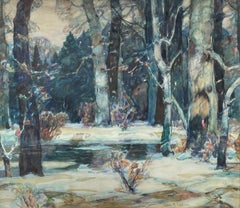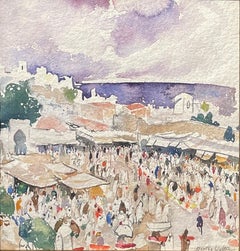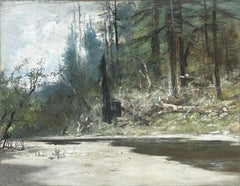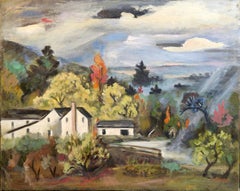Want more images or videos?
Request additional images or videos from the seller
1 of 7
Ernest Fiene"China Town" Ernest Fiene, 1925 Modernist Watercolor on Paper Chinatown Scene1925
1925
Price:$2,550
$3,000List Price
About the Item
- Creator:Ernest Fiene (1894-1965, American)
- Creation Year:1925
- Dimensions:Height: 23 in (58.42 cm)Width: 19 in (48.26 cm)
- More Editions & Sizes:Unique WorkPrice: $3,000
- Medium:
- Movement & Style:
- Period:
- Condition:
- Gallery Location:New York, NY
- Reference Number:1stDibs: LU1841215410242
About the Seller
5.0
Platinum Seller
Premium sellers with a 4.7+ rating and 24-hour response times
Established in 2022
1stDibs seller since 2022
122 sales on 1stDibs
Authenticity Guarantee
In the unlikely event there’s an issue with an item’s authenticity, contact us within 1 year for a full refund. DetailsMoney-Back Guarantee
If your item is not as described, is damaged in transit, or does not arrive, contact us within 7 days for a full refund. Details24-Hour Cancellation
You have a 24-hour grace period in which to reconsider your purchase, with no questions asked.Vetted Professional Sellers
Our world-class sellers must adhere to strict standards for service and quality, maintaining the integrity of our listings.Price-Match Guarantee
If you find that a seller listed the same item for a lower price elsewhere, we’ll match it.Trusted Global Delivery
Our best-in-class carrier network provides specialized shipping options worldwide, including custom delivery.You May Also Like
Walking along the sea. 2024, gouache, paper, 25x25 cm
Located in Riga, LV
Walking along the sea. 2024, gouache, paper, 25x25 cm
Ansis Butnors (1977)
Education:
J. Rozentals Art School in Riga – 1989. – 1996.
Latvian Academy of Art, Painting Department –...
Category
2010s Modern Figurative Paintings
Materials
Paper, Gouache
$529
H 9.85 in W 9.85 in D 0.04 in
1950s "Figure in Shadow" Figurative Gouache Painting America Modernist
By Donald Stacy
Located in Arp, TX
Donald Stacy
"Figure in Shadow"
c.1950s
Gouache paint on paper
24" x 18" unframed
Unsigned
Came from artist's estate
Donald Stacy (1925-2011) New Jersey
Studied: Newark School of Fine Art
The Art Students League
Pratt Graphic Arts Center
University of Paris 1953-54
University of Aix-en-Provence 1954-55
Faculty: Art Department of the New School
Museum of Modern Art
School of Visual Arts
Stacy Studio Workshop
Exhibitions: Grand Central Moderns
George Wittenborn
The New School
Print Exhibitions, Chicago
University of Oklahoma
Honolulu Museum
Monclair Museum
Wisconsin State College
Louisiana Art...
Category
Mid-20th Century American Modern Figurative Paintings
Materials
Paper, Gouache
Mid Century Landscape Figure Painting Art Institute of SF Green, Red, Blue
By Gloria Dudfield
Located in Arp, TX
Gloria Dudfield (1922-2015)
Untitled
c.1960s
Gouache on paper
18"x15" unframed
Unsigned
Came from a portfolio of her work in the San Francisco Bay Area.
Gloria had a Master of Arts...
Category
Mid-20th Century Modern Figurative Paintings
Materials
Paper, Gouache
$325
H 15 in W 18 in D 1 in
'Any Day in America', Social Realist, Beat Generation, Allen Ginsberg
By Ron Croci
Located in Santa Cruz, CA
'Any Day in America' by Ron Croci.
Social Realist, Beat Generation, Allen Ginsberg
-----
Signed lower right, "Croci" for Ron Croci (American, born 1945), and painted circa 1970.
A ...
Category
1970s American Modern Figurative Paintings
Materials
Watercolor, Handmade Paper
$5,500
H 22.5 in W 30.5 in
Society of Six Street Scene - Figurative Abstract
By Bernard Von Eichman
Located in Soquel, CA
Stunning New York City urban modernist watercolor titled "Summer Afternoon Stroll" by Society of Six artist Bernard Von Eichman (American, 1899-1990), 1...
Category
1930s American Modern Landscape Paintings
Materials
Archival Paper, Watercolor
$7,595
H 28 in W 22 in D 0.25 in
Untitled, Figurative, Watercolour on Paper by Modern Indian Artist "In Stock"
By Anita Roy Chowdhury
Located in Kolkata, West Bengal
Anita Roy Chowdhury - Untitled
Watercolour on Paper
22 x 15 inches
(Unframed & Delivered)
A serene watercolour by Anita Roy Chowdhury, featuring a central leaf surrounded by abstrac...
Category
Early 2000s Modern Figurative Paintings
Materials
Paper, Watercolor
$585
H 22 in W 15 in D 1 in
1950's French Impressionist Painting Ladies Gossiping On The Town Bridge
Located in Cirencester, Gloucestershire
Ladies Gossiping
by Y. Blanchon, French 1950's Impressionist artist
signed gouache on artist paper stuck on paper, unframed
size: 12.5 x 19.5 inches
provenance: from a large private ...
Category
Mid-20th Century Modern Landscape Paintings
Materials
Gouache
$882 Sale Price
20% Off
H 12.5 in W 19.5 in
1950's Modernist Painting Figures Along The French River Bank
By Bernard Labbe
Located in Cirencester, Gloucestershire
French Landscape
by Bernard Labbe (French mid 20th century)
signed original gouache on artist paper
size: 15 x 21 inches
condition: very good and ready to be enjoyed
provenance: the...
Category
Mid-20th Century Modern Landscape Paintings
Materials
Gouache
$882 Sale Price
20% Off
H 15 in W 21 in
20th Century Modernist Painting Steps Leading To Church
By Bernard Labbe
Located in Cirencester, Gloucestershire
French Landscape
by Bernard Labbe (French mid 20th century)
original gouache on artist paper
size: 20.5 x 10 inches
condition: very good and ready to be enjoyed
provenance: the art...
Category
Mid-20th Century Modern Landscape Paintings
Materials
Gouache
$716 Sale Price
20% Off
H 20.5 in W 10 in
1950's Modernist Painting Figures Walking Through Black and White French Street
By Bernard Labbe
Located in Cirencester, Gloucestershire
French Landscape
by Bernard Labbe (French mid 20th century)
original watercolour on artist paper
size: 19 x 12 inches
condition: very good and ready to be enjoyed
provenance: the ar...
Category
Mid-20th Century Modern Figurative Paintings
Materials
Watercolor
Bernard Labbe1950's Modernist Painting Figures Walking Through Black and White French Street, 1950's
$441 Sale Price
20% Off
H 19 in W 12 in
More From This Seller
View All"Forest Landscape" John F. Carlson, circa 1925 American Impressionist Landscape
By John F. Carlson
Located in New York, NY
John F. Carlson
Forest Landscape, circa 1925
Signed lower right
Watercolor on paper
Sight 21 x 24 1/2 inches
The native Swede John Fabian Carlson became a household name in New Yor...
Category
1920s American Impressionist Landscape Paintings
Materials
Paper, Watercolor
"Market Scene, North Africa" Martha Walter, Female Impressionist Scene of Market
By Martha Walter
Located in New York, NY
Martha Walter
Market Scene, North Africa
Signed lower right
Watercolor on paper
9 x 9 inches
Martha Walter was best known as a painter of colorful beach scenes and landscapes. Infl...
Category
Early 20th Century Impressionist Figurative Paintings
Materials
Paper, Watercolor
"Western Wilderness Interior" William Keith, California Tonalist, Forest Stream
By William Keith
Located in New York, NY
William Keith
Western Wilderness Interior
Signed lower left
Watercolor on paper laid on artist board
14 1/2 x 19 inches
A native of Scotland, William Keith became in the late 19th ...
Category
Late 19th Century Tonalist Figurative Paintings
Materials
Paper, Watercolor, Board
"Newton’s Farm" Georgina Klitgaard, Modernist Hazy Autumn Landscape Painting
By Georgina Klitgaard
Located in New York, NY
Georgina Klitgaard
Newton’s Farm
Signed lower right
Oil on canvas
24 1/2 x 30 1/2 inches
Georgina Klitgaard’s art has sometimes gotten lost in the critical propensity to assign art...
Category
Early 20th Century American Modern Figurative Paintings
Materials
Canvas, Oil
"Johnny Walker’s Place" Georgina Klitgaard, 1929 American Modernist Landscape
By Georgina Klitgaard
Located in New York, NY
Georgina Klitgaard
Johnny Walker’s Place, circa 1929
Signed lower right
Oil on canvas
34 x 42 inches
Georgina Klitgaard’s art has sometimes gotten lost in the critical propensity t...
Category
1920s American Modern Figurative Paintings
Materials
Oil
"Central Park South" Georgina Klitgaard, Female Modernist New York Cityscape
By Georgina Klitgaard
Located in New York, NY
Georgina Klitgaard
Central Park South
Signed lower right
Oil on canvas
40 1/2 x 28 inches
Georgina Klitgaard’s art has sometimes gotten lost in the critical propensity to assign ar...
Category
Early 20th Century American Modern Landscape Paintings
Materials
Oil
Recently Viewed
View AllMore Ways To Browse
Thomas Day
Edith White Still Life Painting
Thomas Davis
Ernest Hart
Malaga Painting
Oil Painting Girl White
Oil Paintings Of Game
Oil Paintings Rubens
Old Masters Renaissance Paintings
Rene Jerome
Rene Romero Schuler
Rene Romero
Rossi Oil Paintings
Tamera Avery
Venus Adonis
Vintage Bullfighter Painting
Yossi Stern
African Scene Painting



